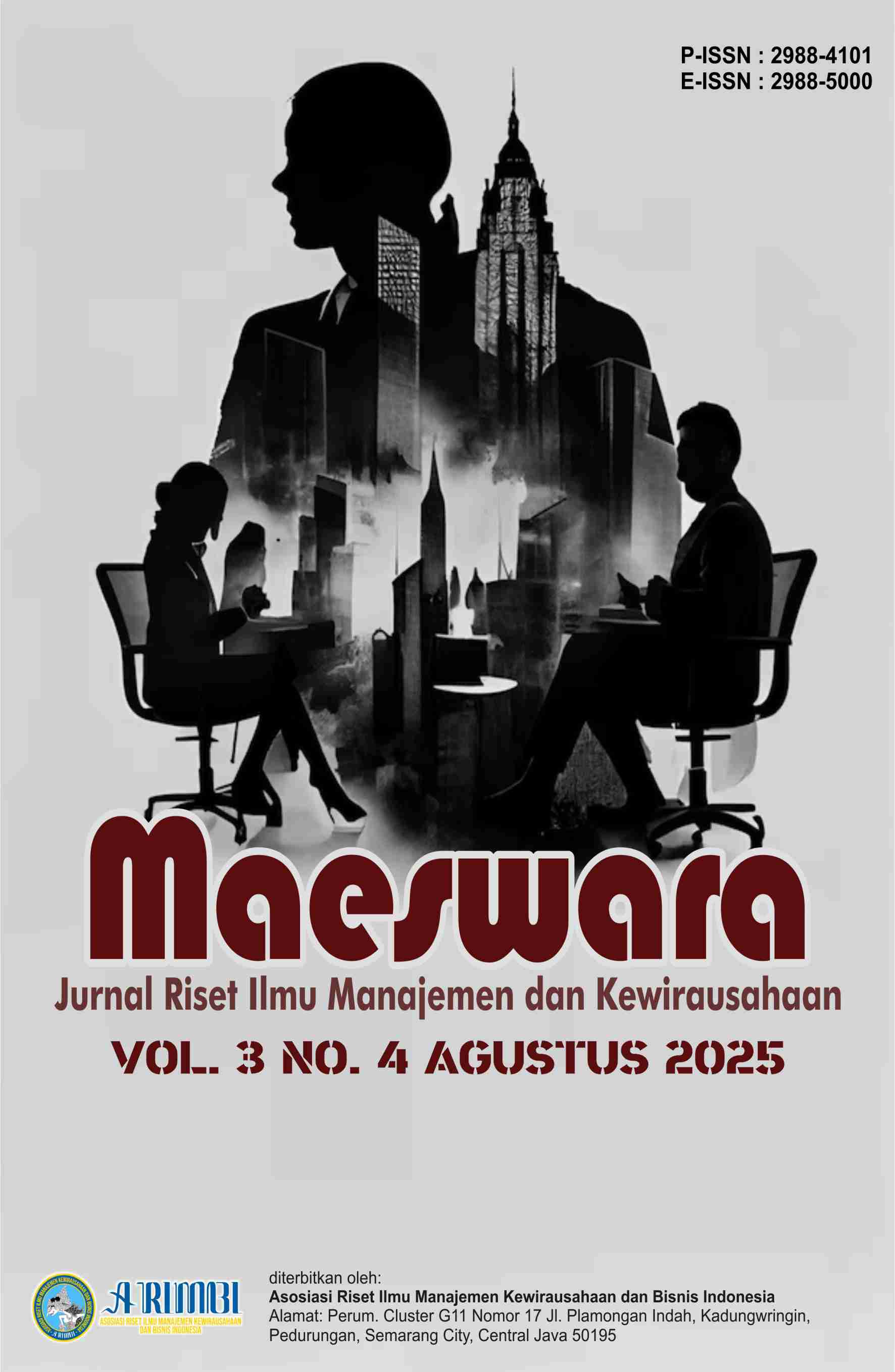Strategi Pemanfaatan E-Commerce untuk Meningkatkan Daya Saing Ekspor UMKM Craft di Indonesia
DOI:
https://doi.org/10.61132/maeswara.v3i4.2107Keywords:
E-Commerce, Export, Digital Marketing, Handicrafts, MSMEsAbstract
This study aims to explore the strategic role of e-commerce in increasing the export of handicraft products by Micro, Small, and Medium Enterprises (MSMEs) in Indonesia, with a case study on CV. Palm Craft in Kediri. In the context of globalization and digitalization, e-commerce is an important means for MSMEs to reach the international market, especially in the midst of the challenges of the COVID-19 pandemic that limit conventional export activities. This study uses a descriptive qualitative approach with data collection techniques through observation, in-depth interviews, and documentation. The main focus of this study is how CV. Palem Craft utilizes various digital platforms such as social media (Instagram, Facebook), marketplaces (Tokopedia, Shopee), and global platforms (Amazon, Etsy) to expand market access, build product branding, and increase the selling value of local handicrafts. The results of the study show that the strategic use of e-commerce has helped companies overcome export barriers such as limited distribution networks, logistics constraints, and lack of international promotion. In addition, e-commerce also allows CVs. Palem Craft to build direct relationships with global consumers, get faster feedback, and make product adjustments according to market needs. This research also identifies supporting factors such as digital literacy, product quality, and production capacity as crucial aspects in the success of e-commerce strategies. The implications of this study provide relevant insights for other MSMEs that want to develop exports through the use of digital technology. Continuous support from the government and related institutions is needed in terms of training, access to capital, and digital export facilitation so that Indonesian MSMEs can compete in the global market in a sustainable manner.
Downloads
References
Aziz, Y. A., & Chok, N. V. (2013). The role of Halal awareness, Halal certification, and marketing
components in determining Halal purchase intention among non-Muslims in Malaysia.
Journal of International Food & Agribusiness Marketing, 25(1), 1–23.
Bharadwaj, A., El Sawy, O. A., Pavlou, P. A., & Venkatraman, N. (2013). Digital Business
Strategy: Toward a Next Generation of Insights. MIS Quarterly, 37(2), 471–482.
Braun, V., & Clarke, V. (2006). Using thematic analysis in psychology. Qualitative Research in Psychology, 3(2), 77–101.
Creswell, J. W. (2013). Qualitative Inquiry and Research Design: Choosing Among Five
Approaches (3rd ed.). SAGE Publications.
Denzin, N. K. (2017). The Research Act: A Theoretical Introduction to Sociological Methods.
Transaction Publishers.
Dwivedi, Y. K., et al. (2020). Social media: The good, the bad, and the ugly. Information Systems
Frontiers, 22, 953–957.
Faridah, H. D. (2019). Halal certification in Indonesia: history, development, and implementation.
Journal of Halal Product and Research, 2(2), 68–78.
Govindaraju, R., & Chandra, Y. U. (2011). Challenges of E-Commerce Adoption in SMEs. Jurnal
Sistem Informasi, 7(2), 95–106.
Hardiyanto, D., et al. (2020). Penerapan GIS untuk Pemetaan Potensi UMKM. Jurnal Teknologi
dan Sistem Komputer, 8(1), 32–38.
Kotler, P., & Keller, K. L. (2009). Marketing Management (13th ed.). Pearson Education.
Laudon, K. C., & Traver, C. G. (2020). E-commerce: Business, Technology, Society (16th
ed.). Pearson.
Lincoln, Y. S., & Guba, E. G. (1985). Naturalistic Inquiry. SAGE Publications.
Lestari, Y. D., & Mukhlis, I. (2023). Implementation of Halal Certification in Business Ethics for
the Development of Rambak Center MSMEs. JAMBak, 2(2), 147–154.
Mayzlin, D. (2006). Promotional chat on the internet. Marketing Science, 25(2), 155–163.
Moertini, V. S. (2012). Small Medium Enterprises: On Utilizing B2B E-Commerce to Go Global.
Procedia Economics and Finance, 4, 13–22.
Mulhern, F. J. (2009). Integrated marketing communications: From media channels to digital
Connectivity. Journal of Marketing Communications, 15(2–3), 85–101.
Oestreicher-Singer, G., & Zalmanson, L. (2013). Content or Community? A Digital Business
Strategy for Content Providers in the Social Age. MIS Quarterly, 37(2), 591–616.
Purwana, D., Rahmi, R., & Aditya, S. (2017). Pemanfaatan Digital Marketing Bagi UMKM di
Kelurahan Malaka Sari. JPMM, 1(1), 1–17.
Ramadhanti, N. P., Afifah, N., & Kautsar, T. S. (2025). Dampak Penerapan E-Commerce Amazon
terhadap Peningkatan Ekspor UMKM di Indonesia. JIRS, 2(1), 563–573.
Rahman, F., Sumarwan, U., & Sahara, S. (2019). Analisis Preferensi Konsumen terhadap Produk
Halal. Jurnal Manajemen dan Agribisnis, 16(2), 121–130.
Smith, A. D. (2011). Cyber Promotions in Online Retailing: Interactive Marketing and Social
Networking. Journal of Retailing and Consumer Services, 18(4), 280–285.
Tambunan, T. (2019). Recent evidence of the development of micro, small and medium enterprises
in Indonesia. Journal of Global Entrepreneurship Research, 9(1), 1–15.
Tamam, F. S. H., et al. (2024). Peran E-Commerce dalam Transformasi Ekspor Impor di Era
Digital. SINERGI: Jurnal Riset Ilmiah, 1(12), 1332–1340.
Utami, S., & Purnomo, D. (2021). Efektivitas Digital Marketing dalam Promosi Produk Kuliner
Tradisional. Jurnal Komunikasi dan Media, 5(1), 45–57.
Winarsih, S., Indriastuti, M., & Fuad, K. (2021). Impact of COVID-19 on Digital Transformation
and Sustainability in SMEs. Journal of Open Innovation: Technology, Market, and
Complexity, 7(1), 104.
Yogi Dwi Lestari, & Sudarmiatin. (2024). Optimization of Digital Marketing in Increasing Sales
BAKPIA Masaji Kediri UMKM Products. JAMBak, 3(1), 77–86
Downloads
Published
How to Cite
Issue
Section
License
Copyright (c) 2025 Maeswara : Jurnal Riset Ilmu Manajemen dan Kewirausahaan

This work is licensed under a Creative Commons Attribution-ShareAlike 4.0 International License.





